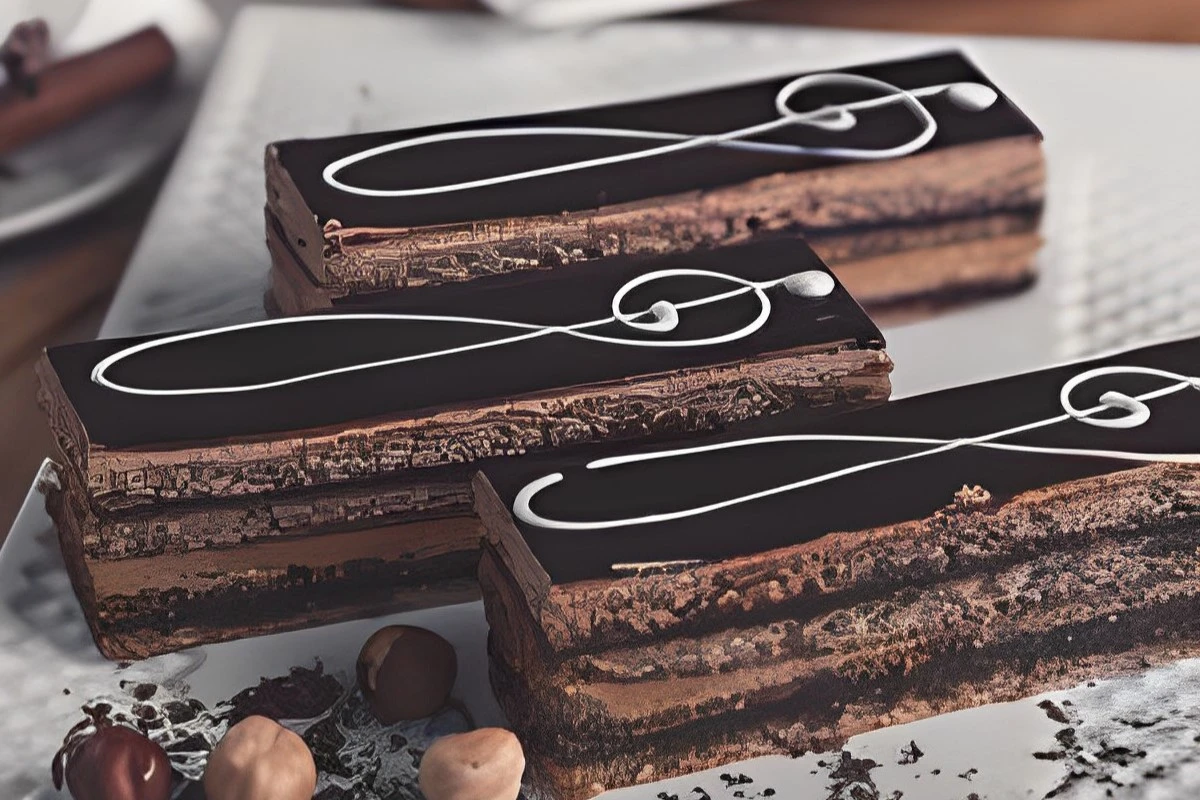Table of Contents
Delving into the world of gourmet desserts, the opera cake stands out as a masterpiece of French patisserie. Why is it called an opera cake, you might wonder? This article embarks on a journey to uncover the origins, layers, and cultural significance of the opera cake. Known for its intricate layers and exquisite taste, the layered espresso cake is more than just a dessert; it’s a symbol of culinary artistry and tradition. From its storied beginnings to the modern interpretations that continue to enchant dessert lovers worldwide, we’ll explore what makes the opera cake a beloved classic. Join us as we peel back the layers of history, technique, and flavor that define this iconic treat.
The Origins of Opera Cake
The story of the opera cake is as rich and layered as the dessert itself. This section delves into the cake’s creation, exploring how it came to be associated with the opulence and grandeur of the opera.
A Slice of History
Culinary historians believe that the early 20th century saw the creation of the opera cake, known in French as “Gâteau Opéra.” While its exact origins spark debate, many widely attribute it to the famous Parisian patisserie Dalloyau. The design of the cake aims to captivate the senses, much like the opera itself, offering a harmonious blend of flavors and textures in every bite.
Cultural Significance (Why is it called an opera cake?)
The opera cake’s name is said to be inspired by the Paris Opera, reflecting its elegance and depth. It quickly became a symbol of French culinary excellence, celebrated for its intricate construction and the skill required to perfect it. The cake’s layers of almond sponge (joconde), coffee syrup, ganache, and coffee buttercream, topped with a chocolate glaze, mirror the complexity and beauty of an opera performance, making each slice a grand show in its own right.
The French opera dessert not only delights the palate but also tells a story of tradition, artistry, and the pursuit of perfection. It stands as a testament to the enduring appeal of French desserts and the cultural heritage they represent.
The Anatomy of an Opera Cake
An opera cake’s allure lies in its complexity and balance, achieved through the precise assembly of its components. Consequently, let’s dissect this culinary work of art layer by layer.
Decoding the Layers
- Almond Sponge (Joconde): The foundation of the opera cake, this light and airy sponge is made from almond flour, sugar, eggs, and flour. It’s the canvas for the other flavors, imbued with coffee syrup to add moisture and a subtle coffee aroma.
- Coffee Syrup: Brushed onto each layer of joconde, the coffee syrup enhances the cake with a rich, aromatic depth. It’s a simple yet crucial element that ties the layers together, providing both flavor and moisture.
- Ganache: A velvety mixture of chocolate and cream, ganache adds a luxurious richness to the cake. Its smooth texture contrasts beautifully with the light sponge, offering a melt-in-your-mouth experience.
- Coffee Buttercream: This silky buttercream, flavored with strong coffee or espresso, offers a creamy, indulgent layer that complements the bittersweet notes of the chocolate.
- Chocolate Glaze: A glossy chocolate glaze crowns the opera cake, adding a final touch of chocolatey indulgence and giving the cake its signature polished appearance.
The Art of Assembly
Creating an opera cake is akin to conducting an orchestra, where each element must come together in perfect harmony. The assembly process requires patience and precision, layering the joconde with coffee syrup, ganache, and coffee buttercream before topping it off with the chocolate glaze. The result is a visually stunning dessert that’s as pleasing to the eye as it is to the palate.
The opera cake’s structure goes beyond aesthetics; it’s a deliberate mix ensuring each bite has balanced flavors and textures. From the almond sponge to the rich ganache and buttercream, each element is crucial to the cake’s taste.
Variations and Modern Interpretations
The opera cake’s adaptability has allowed it to remain a beloved dessert across generations, with each variation offering a unique taste experience. Let’s explore how regional influences and contemporary culinary trends have introduced exciting new dimensions to this iconic cake.
Regional Variations
Across different cultures, the opera cake has been reimagined to incorporate local flavors and ingredients, resulting in delightful regional variations. For instance, some versions replace the traditional coffee flavor with green tea or matcha, offering a subtle bitterness that complements the sweetness of the chocolate. Others might incorporate local nuts or fruits, adding a layer of texture and flavor that reflects the region’s culinary heritage.
Contemporary Twists
In the hands of modern pastry chefs, the opera cake has undergone transformations that push the boundaries of dessert innovation. Some of these contemporary interpretations include:
- Deconstructed Opera Cake: Breaking down the components of the opera cake and presenting them in a new, artistic form, allowing each element to shine on its own while maintaining the harmony of flavors.
- Opera Cake with Alternative Flours: Gluten-free versions of the French opera dessert use alternative flours, making the dessert accessible to those with dietary restrictions without compromising on taste or texture.
- Flavor Infusions: Experimenting with infusions such as lavender, citrus, or even spices like cardamom, chefs have added layers of complexity to the opera cake’s flavor profile, creating a sensory experience that’s both familiar and novel.
These variations and modern interpretations showcase the opera cake’s versatility and its ability to inspire creativity in the kitchen. By embracing new techniques and flavors, chefs continue to pay homage to the opera cake’s rich history while ensuring its place in the future of pastry.
FAQs on Making Opera Cake
Can I Make Opera Cake Without Coffee?
Yes, while coffee traditionally flavors French opera dessert, you can substitute or omit it based on personal preference. You can use alternatives like matcha, vanilla syrup, or even fruit purées to infuse the layers with different flavors.
How Do I Ensure My Layers Are Even?
Achieving even layers in an opera cake requires precise measurement and a steady hand. Use a ruler to guide the size of your sponge layers when cutting, and apply fillings with a palette knife for uniform thickness. Weighing the amount of filling for each layer can also help maintain consistency.
Can Opera Cake Be Made in Advance?
Opera cake is an excellent make-ahead dessert. Its flavors meld and deepen over time, making it even more delicious a day or two after assembly. Just make sure to store it in an airtight container in the refrigerator and add the final glaze or decoration closer to serving time to maintain its appearance.
How Do I Cut Clean Slices of Opera Cake?
For clean, precise slices, use a sharp, warm knife. Dip the knife in hot water and wipe it dry between cuts. This method melts through the chocolate glaze smoothly and ensures the layers remain intact.
Is Opera Cake Gluten-Free?
Traditional opera cake recipes, which include flour in the joconde sponge, are not gluten-free. However, you can indeed create gluten-free versions by substituting the traditional flour with almond flour or a baking-specific gluten-free flour blend.
How Long Can Opera Cake Be Stored?
When stored properly in the refrigerator, opera cake can last up to 4 days. For the best texture and flavor, let it come to room temperature for about 20 minutes before serving.
Mastering the Opera Cake
Creating a French chocolate cake is a rewarding endeavor that challenges and hones your baking skills. Here are some final tips to ensure your almond coffee cake is as delightful to make as it is to eat:
Embrace Precision
- Precision in measurement, cutting, and assembly is key to achieving the opera cake’s signature elegance. Take your time with each step, and don’t rush the process.
Experiment with Flavors
- While the classic coffee and chocolate combination is iconic, don’t be afraid to experiment with flavors. Infusing the cake with teas, spices, or fruit purées can yield exciting and personalized results.
Practice Makes Perfect
- Mastery of the opera cake may not come on the first try, and that’s perfectly okay. Each attempt is a learning experience, bringing you one step closer to perfection.
Share Your Creations
- Opera cake is meant to be shared. Whether it’s a special occasion or a casual gathering, presenting an French layer cake you’ve made is a sure way to impress and delight your guests.
Continue Learning
- The world of patisserie is vast and ever-evolving. Therefore, continue exploring new techniques, flavors, and desserts to expand your baking repertoire beyond the opera cake.
The opera cake, rich in flavors and intricate layers, is not just a dessert; it celebrates the culinary arts. Whether following the traditional recipe or exploring your own variations, making a french opera dessert is a rewarding journey. Let your kitchen brim with baking joy, and let your opera cakes showcase your dedication and creativity. Happy baking!





